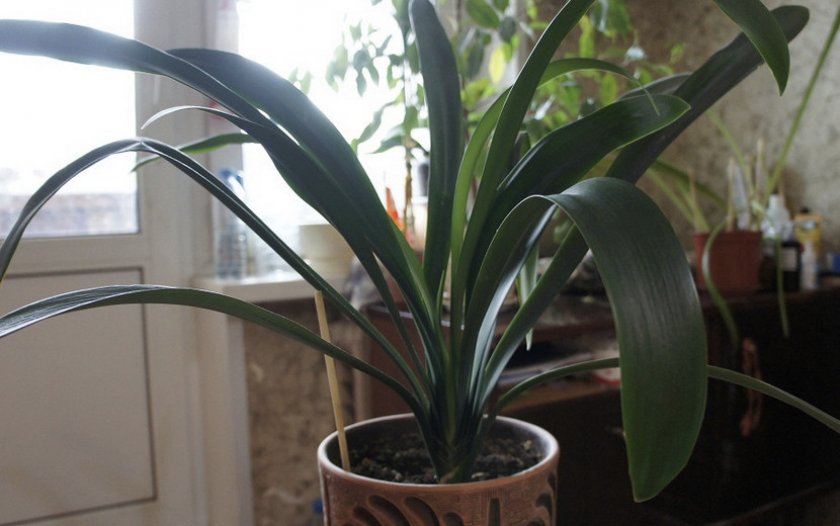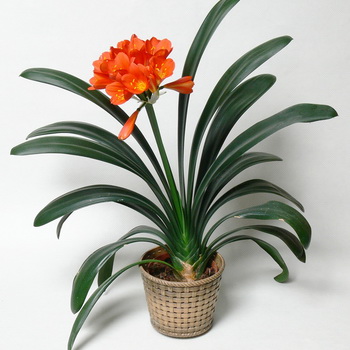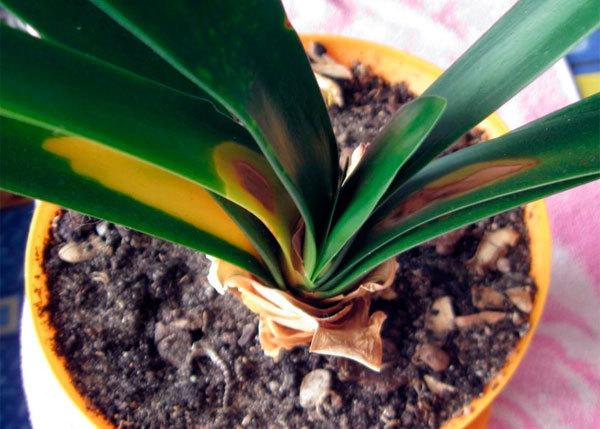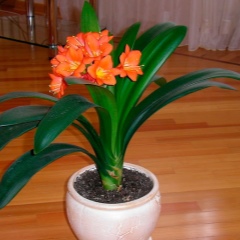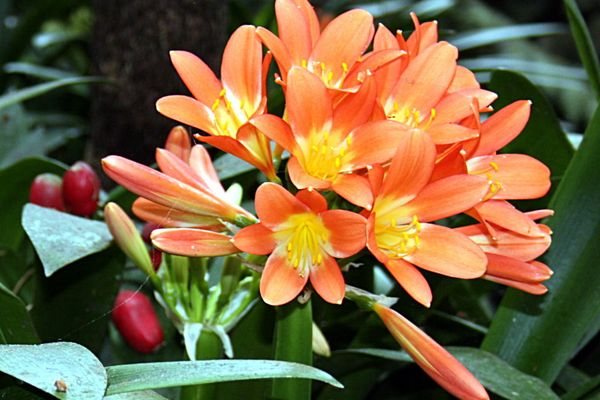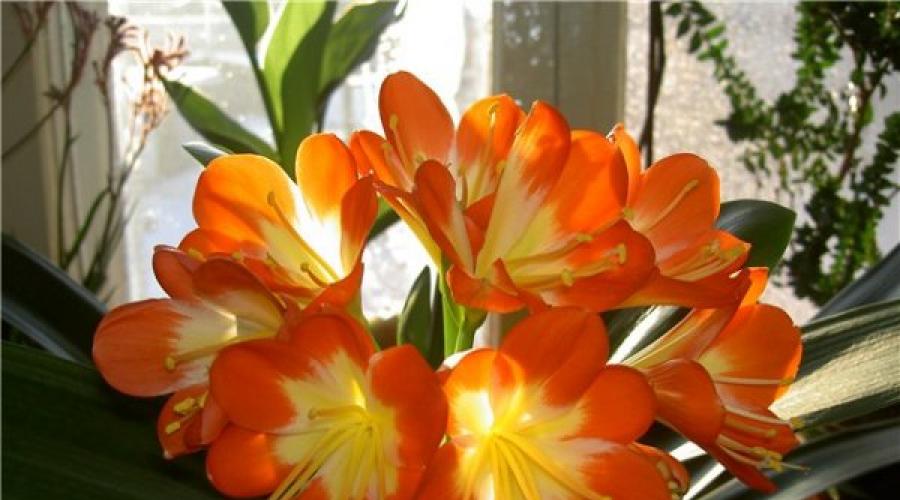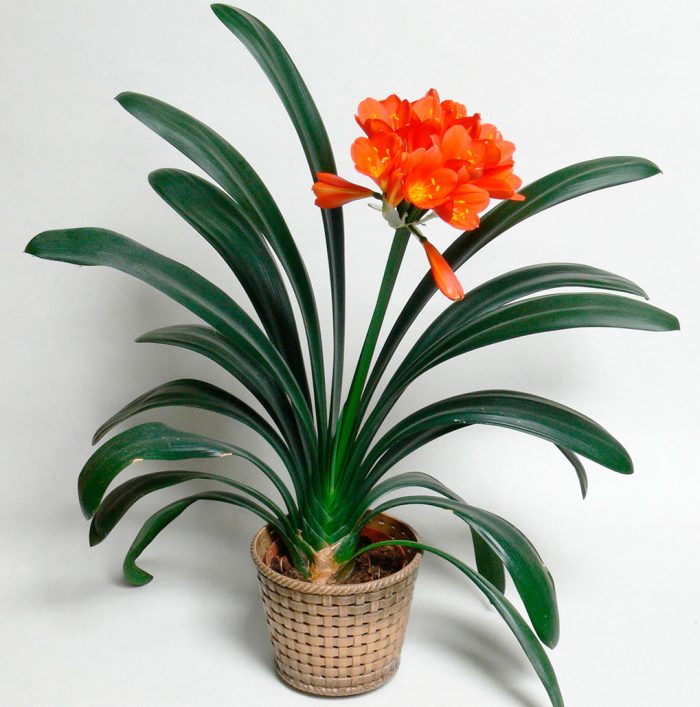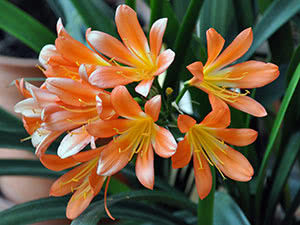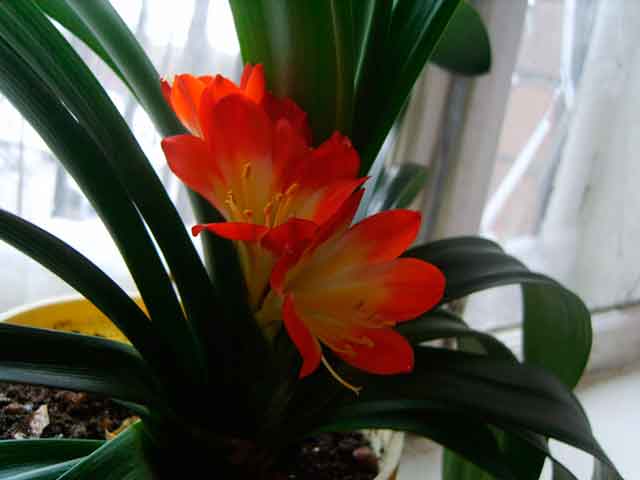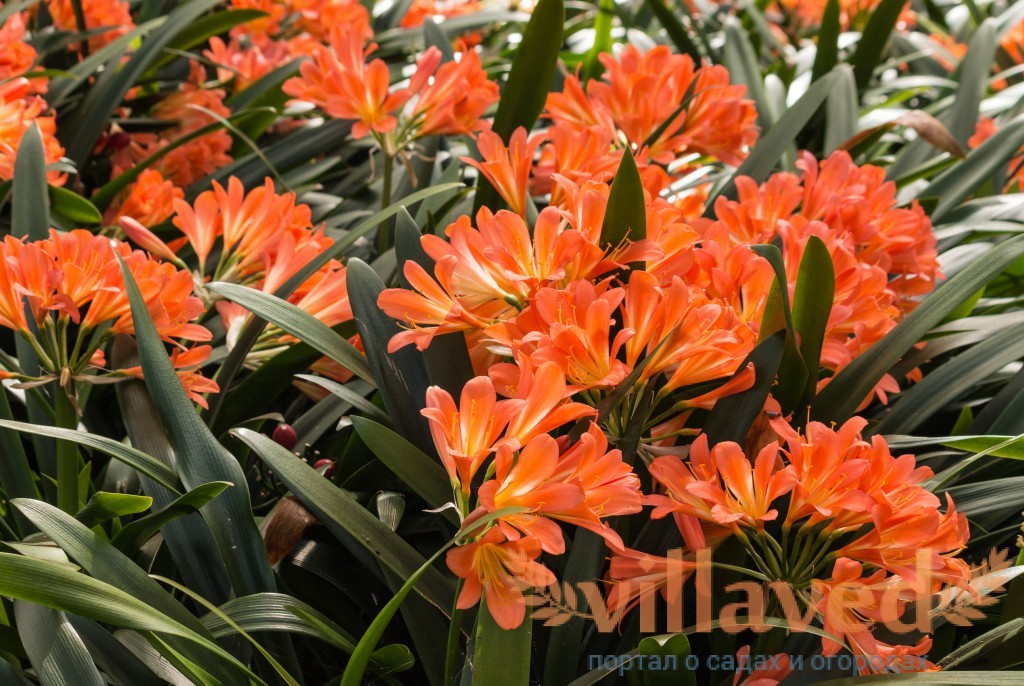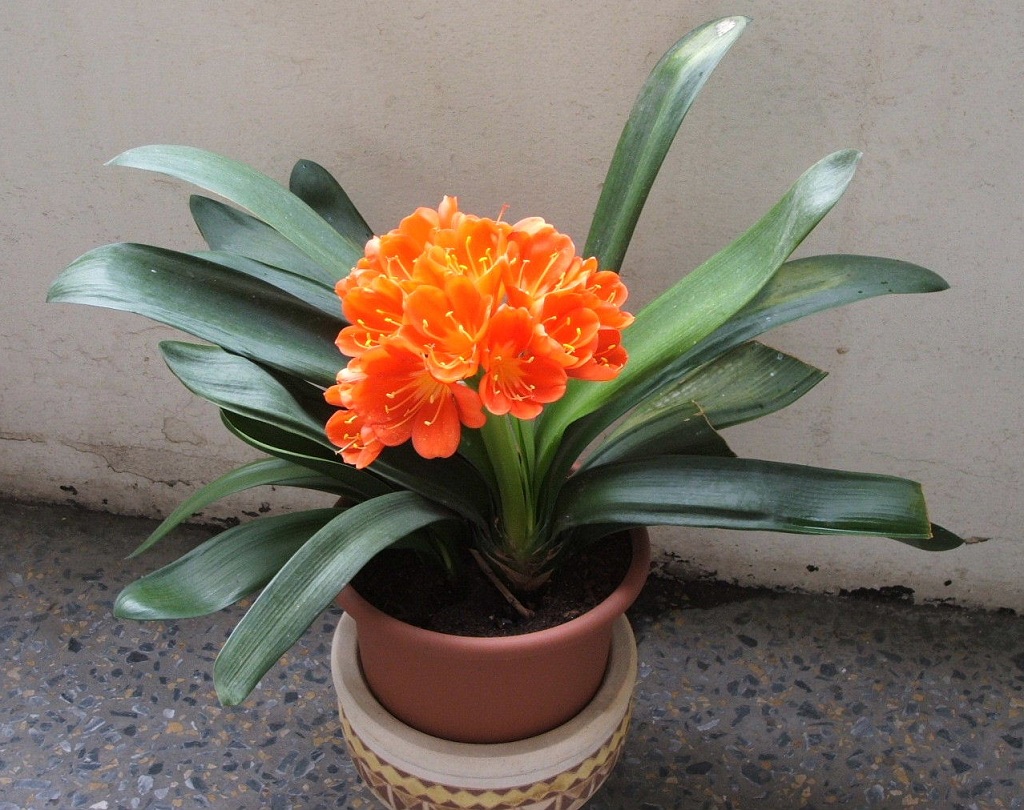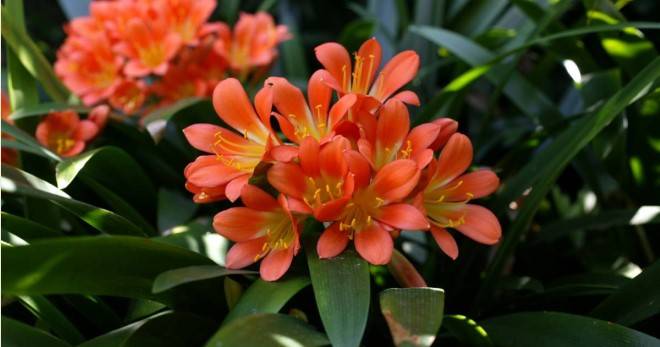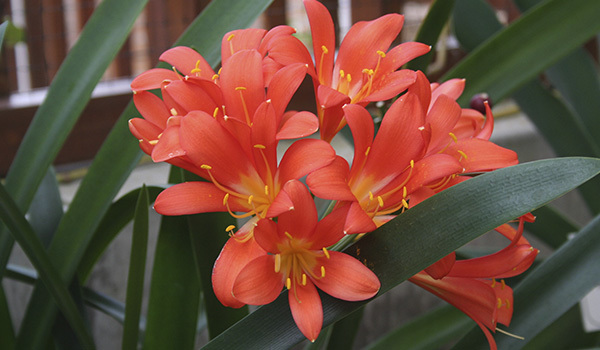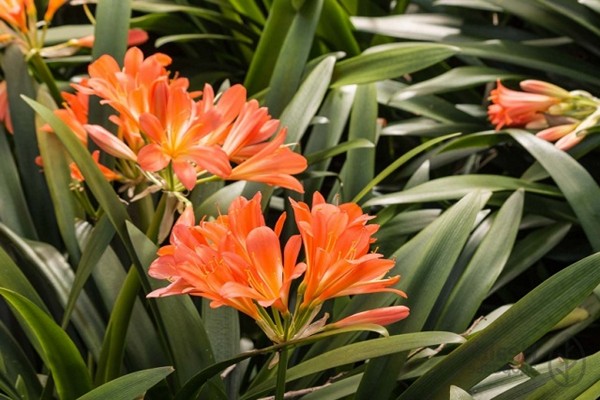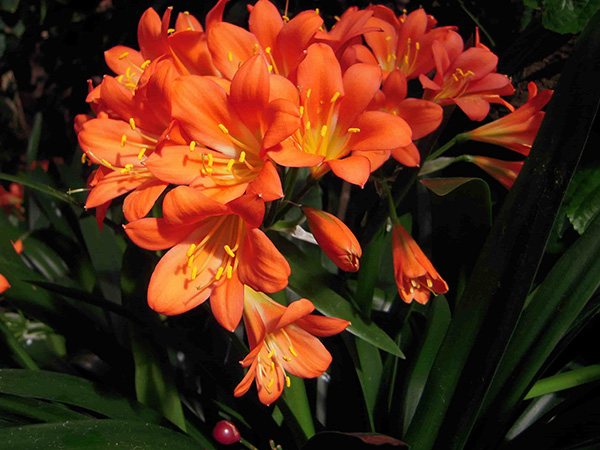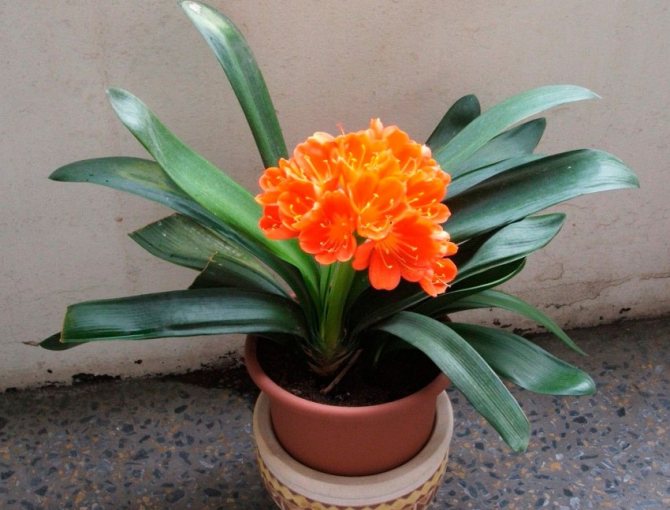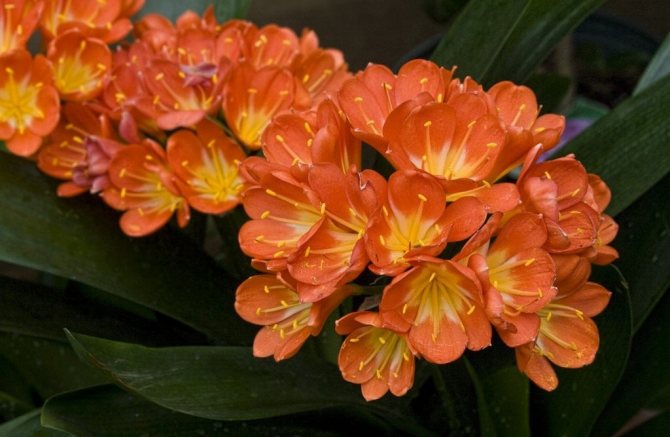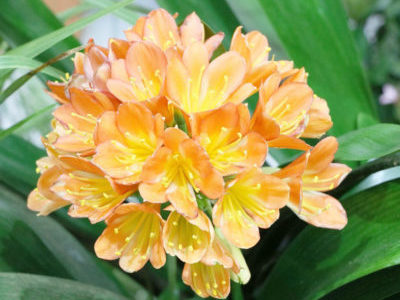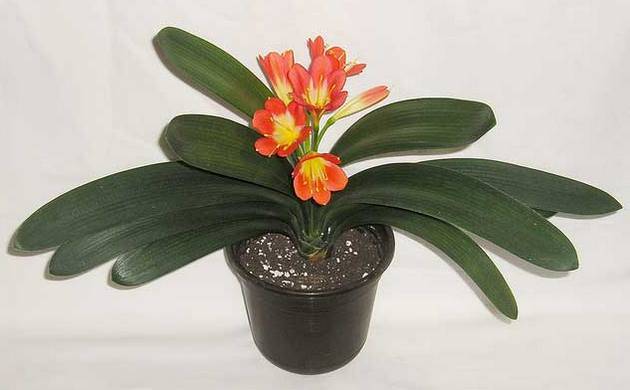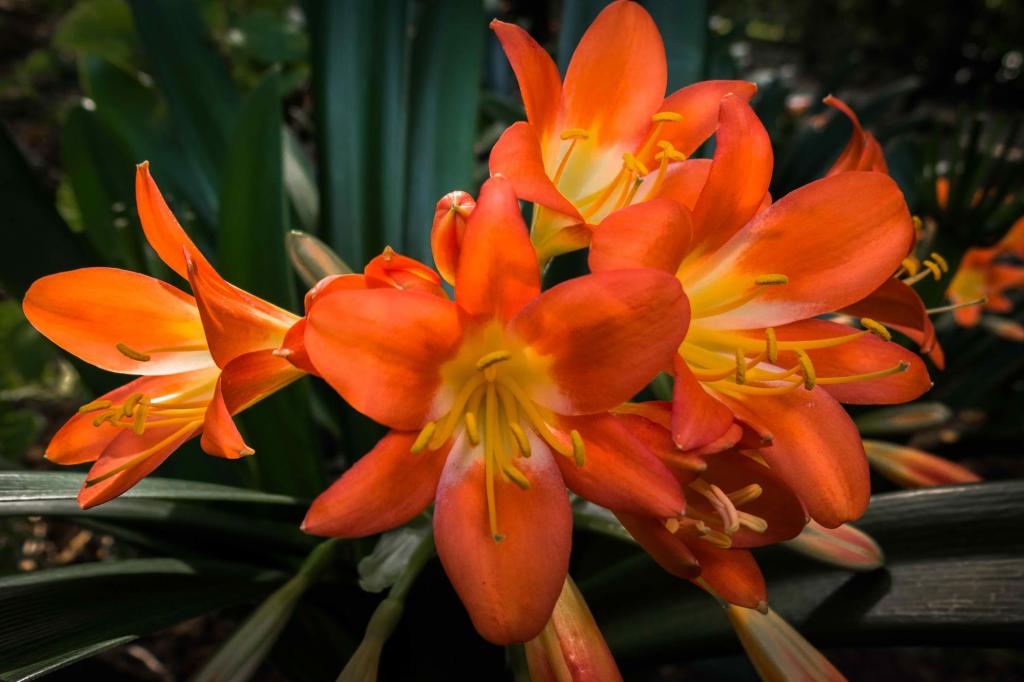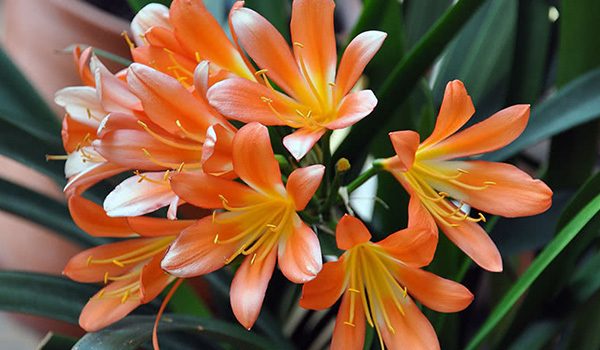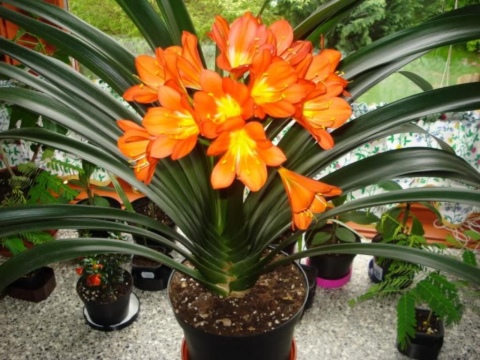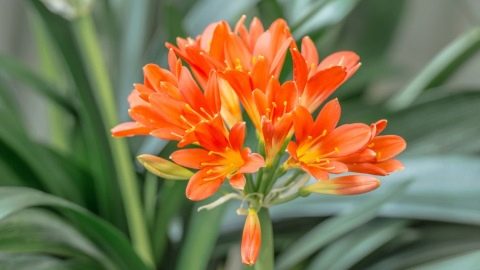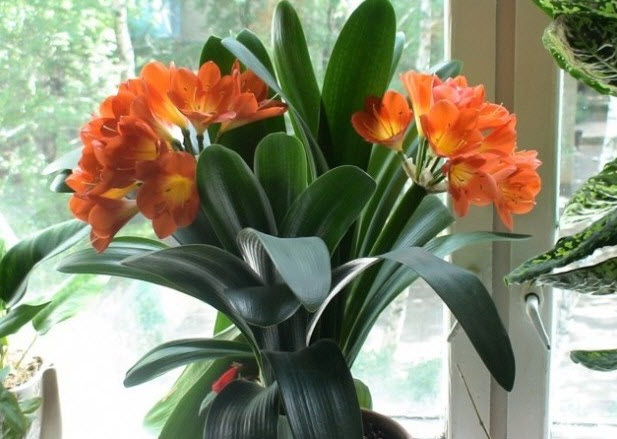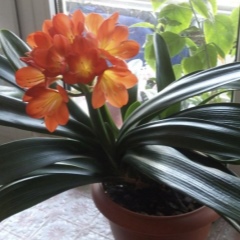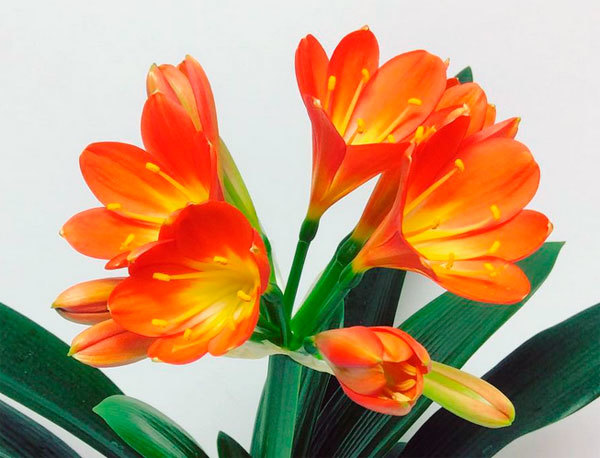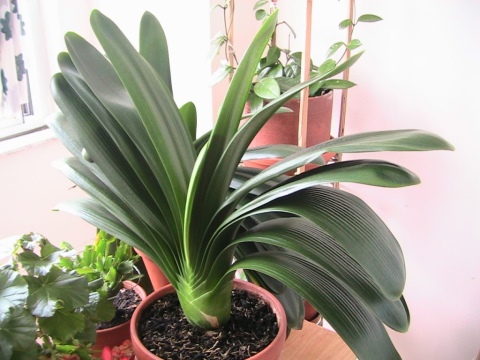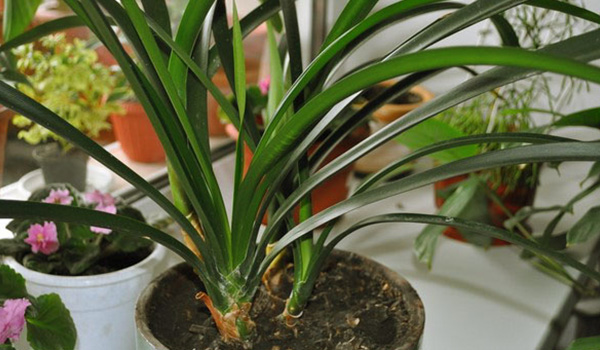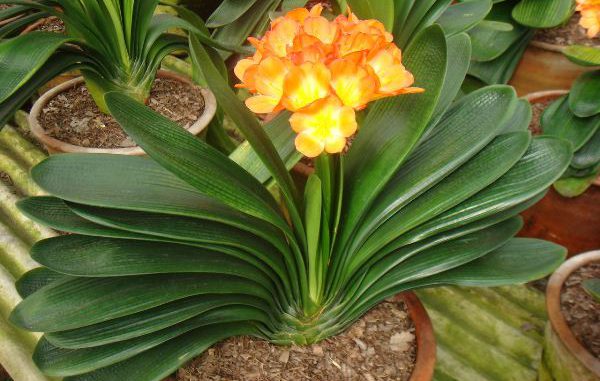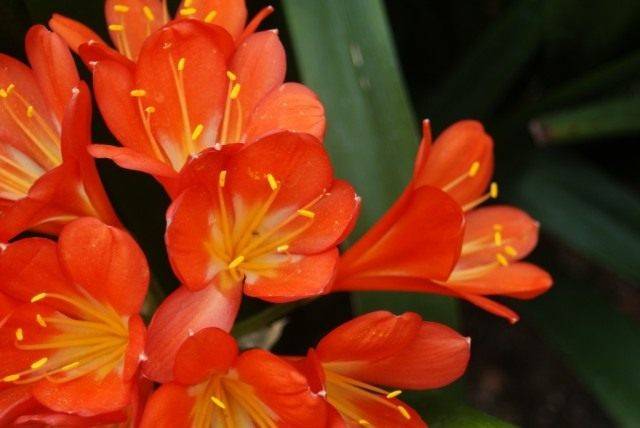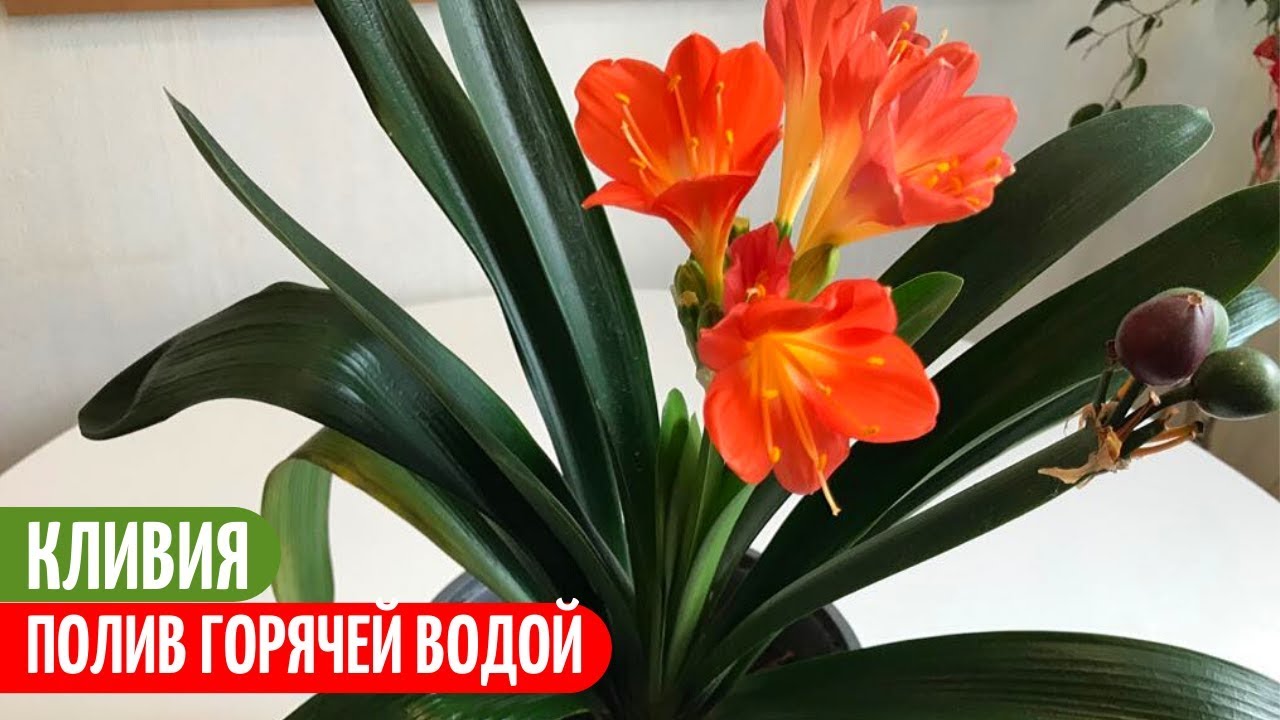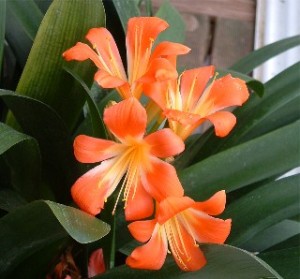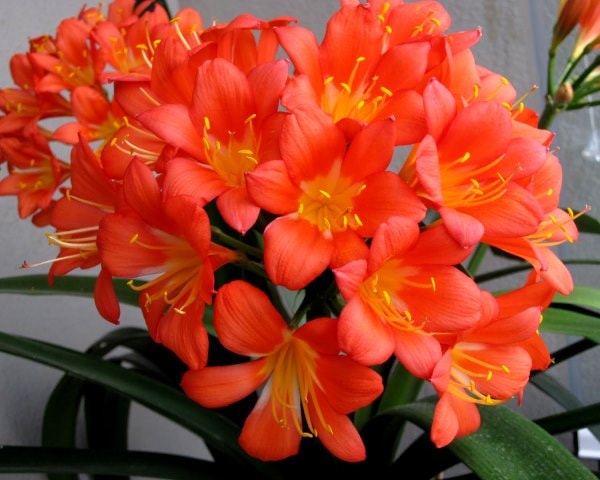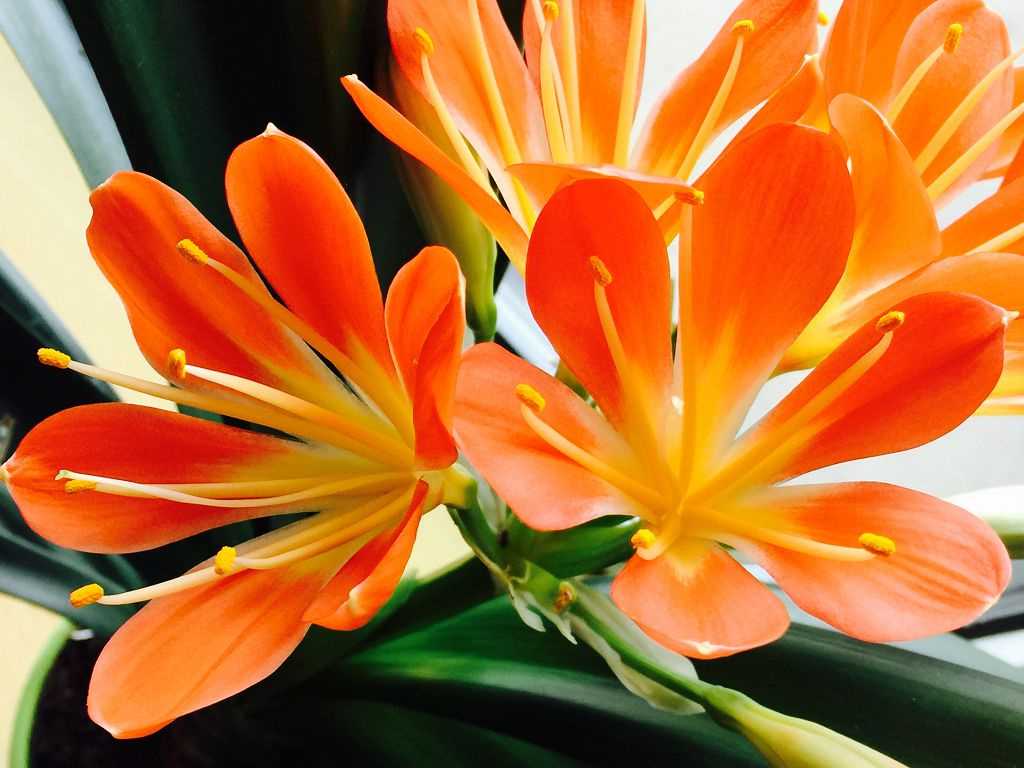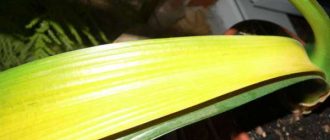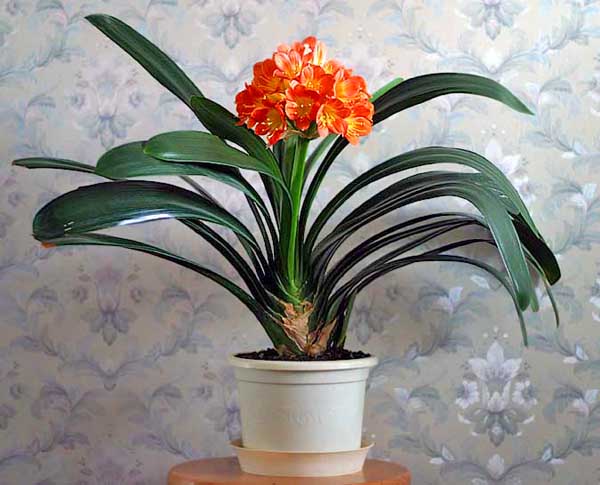Flower varieties
Clivias are evergreen perennial herbaceous plants, stemless, multi-flowered. Vaginal leaves, tightly enclosing each other, forming a false stem, linear or xiphoid. Under the ground, the culture develops a rhizome, to which the thickened bases of the leaves and the leaves themselves are attached. The plant is, as it were, in the middle between bulbous and rhizome cultures. The flowers are bell-shaped, red or orange.

Types of culture
Clivia cinnabar
One of the most common is Clivia cinnabar. It is used as a floral and deciduous ornamental pot plant. The birthplace of culture is South Africa. Until it blooms, it is almost impossible to distinguish it from the beautiful clivia. Its leaves reach a length of 70 cm, have a belt-like shape and a dark green color. The flowers of this species are red-orange, the bases of the petals are yellowish. Up to 20 flowers are formed on one peduncle. It begins to bloom in spring. It was this species that became the basis for the development of other new varieties.

Clivia miniata
Clivia lemon
The next very common type is lemon clivia, or citrine clivia. The leaves of the plant reach a length of 70 cm, have a belt-like shape and a medium green color. The flowers in this top view are white, at the base they are yellowish. Up to 15-20 flowers are formed on one peduncle. Blossoms in the spring.

Clivia miniata Citrina
Clivia the beautiful or nobilis
It has the same belt-like or tag-like leaves, reaching up to 40 cm in length (up to half a meter). The flowers are long, funnel-shaped, light red with green at the ends of the petals. There are from 30 to 60 of them in the inflorescence. Flowering time is from late February to late spring.
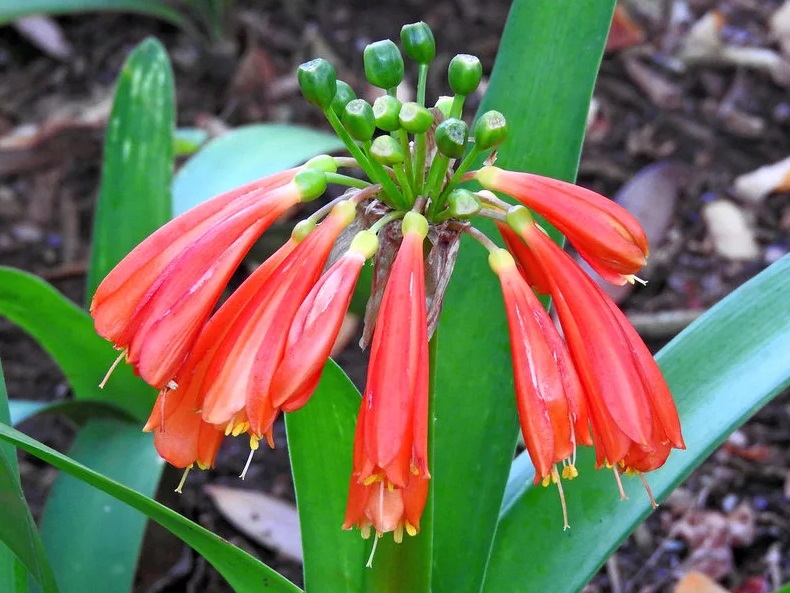
Clivia nobilis
Growing conditions and conditions for clivia
Tropical exotic, contrary to popular belief, is rather unpretentious and does not need special attention. For the normal development of an indoor flower, it is enough to follow the basic agrotechnical rules.
Lighting requirements
A native of tropical rainforests does not like direct sunlight, and therefore needs to create a little shade. Eastern or western window sills are best suited for kaffir lily. On the north side, the plant will also take root well, but it will significantly slow down in growth. In winter, it is recommended to remove the pot with clivia from the window, moving it to a nearby table.
 A tropical flower does not like direct sunlight
A tropical flower does not like direct sunlight
Temperature and humidity
A heat-loving culture will feel comfortable at room temperature, which is in a constant range from +20 to +25 ° С. When the dormant period begins for the flower, the temperature indicators can be reduced to + 12-15 ° C. The humidity level in the room where the flowerpot with tropical exotic is located should be no more than 50%. This is usually the standard figure for most apartments.
Soil composition
Soil for clivia is chosen nutritious, light, well-drained. From store options, a universal substrate or soil mixture for bulbous crops is suitable. To make the kaffir lily grow better, a little garden or coniferous soil is mixed into the substrate.
You can prepare the potting soil yourself. To do this, it is necessary to combine leafy earth, turf and coarse river sand in equal proportions.
Author's advice
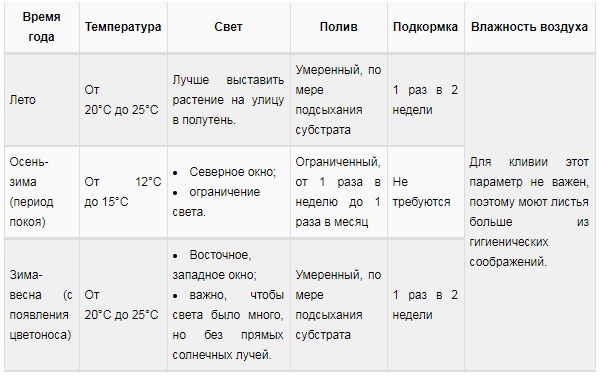 Table: Optimal conditions for clivia by seasons
Table: Optimal conditions for clivia by seasons
Transplantation and reproduction of indoor flower
Kaffir lily multiplies very quickly, and the procedure itself does not take much time. Florists breed clivia in two ways: by layering and by seeds. We will discuss these methods in more detail below.
Growing from seeds
To speed up the process, connoisseurs of indoor plants are advised to use purchased seed.The reproduction algorithm is as follows:
- seeds are immersed in a container with warm, settled water for 24 hours;
- the container is filled with a sand-peat mixture, and then the seeds are sown at a distance of 5-6 cm from each other;
- cover with cling film on top, thereby creating greenhouse conditions;
- before the first shoots appear, polyethylene is regularly removed for ventilation;
- when the first full-fledged leaf is formed, a pick is carried out, seating the seedlings in separate pots.
Reproduction by children
The procedure for transplanting children is carried out only after the donor plant has faded. It consists in the following:
- small shoots are carefully separated from the mother bush with a sharp knife, leaving a part of the rhizome on them;
- the places of the cuts are sprinkled with activated carbon or cinnamon;
- delenki are placed in a sandy-peat substrate and looked after as if they were an adult flower.
 Indoor plant is propagated by children
Indoor plant is propagated by children
Watering and feeding rules
Tropical exotic is very demanding for watering. When the plant releases an arrow and buds begin to form, the flower is moistened 2-3 times a week using soft, settled water at room temperature. The rest of the time, irrigation is carried out as the topsoil dries out, preventing moisture stagnation.
Kaffir lily is fertilized from April to September, twice a month. For this, potassium-phosphorus mineral complexes and organics are used in turn. In order not to harm the plant, the dose is taken half as much as prescribed in the instructions.
Leaving during flowering
Immediately after winter, the flower wakes up and throws out a small peduncle about 15 cm long. At this time, warmer conditions and good lighting are created for the clivia. Watering is carried out every other day using warm, soft water. The temperature is maintained within + 22-25 ° С, excluding sharp jumps. Until the arrow grows and the flowering ends, it is strictly forbidden to rearrange the pot.
 After waking up, the flower is watered every other day.
After waking up, the flower is watered every other day.
As soon as the kaffir lily fades, it needs a couple of months to rest for future buds to form. For this period, the flower pot is moved to a cooler place, providing a temperature of + 12-15 ° C. Watering is reduced to once a week, and feeding is completely removed.
Reproduction and transplantation
For reproduction of clivia, either seeds or lateral shoots, called babies, are used. The second method is considered both simpler and more effective. The babies are carefully separated from the adult plant using a processed tool. If the roots are tangled, then it will be possible to separate them with a knife. The wounds are treated with crushed coal, after which the children are dried for about half an hour. The process is to be planted in a small pot, which is then exposed on a warm and light windowsill. Its flowering will begin in a couple of years.
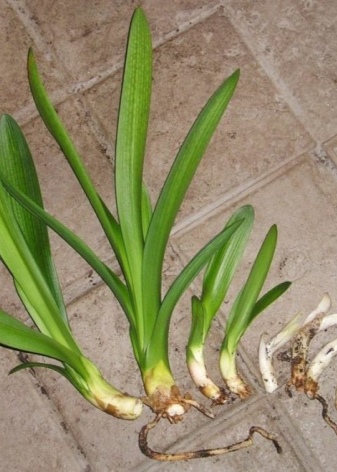
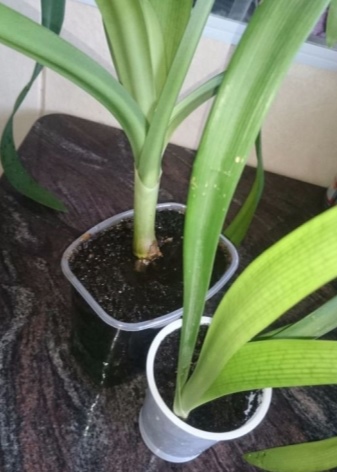
Seed material for clivia is most often purchased in the store, since it is rather difficult to obtain it yourself. However, some gardeners still try to cope with this task, despite the fact that the full formation of the fruit sometimes depletes the strength of the plant. First, the bush is artificially pollinated using a soft brush. After about 9 months, the fruit should appear. As soon as their color turns red and the structure softens, the seeds can be removed and put into water for a day to swell.
The planting itself is carried out immediately so that the material does not lose its germination. The substrate is formed from peat and perlite or a mixture of peat, turf and sand. The seeds are distributed so that between 2 and 6 centimeters remains between them. The container is covered with a glass sheet or polyethylene. Every day, the greenhouse will have to be opened for a quarter of an hour for ventilation, and the surface of the earth will be moistened.
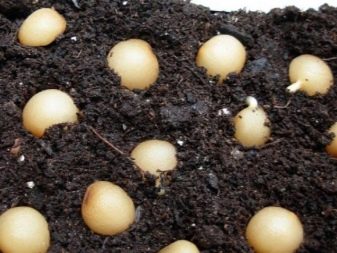
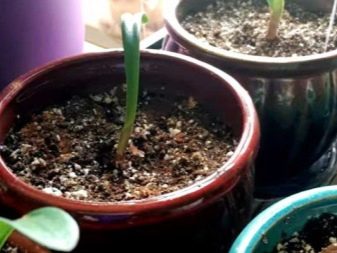
During transplantation, clivia is under great stress, so you should not carry out the procedure until the roots begin to protrude from the pot.An adult plant is not touched at all for a couple of years, after which it is moved to a larger pot as soon as flowering is complete. Only young bushes should be replanted every year. This is done with great care, since the slightest damage to the root system leads to the development of a putrefactive process
When a wound does arise, it is immediately important to treat it with crushed coal.
There is no need to transplant Klivia, which has already reached the age of 10. It is enough to simply renew the topsoil with a height of 3 to 5 centimeters. The pot for transplanting does not need to be taken too large, since all efforts will go to the development of the root system, and not to the release of the peduncle.

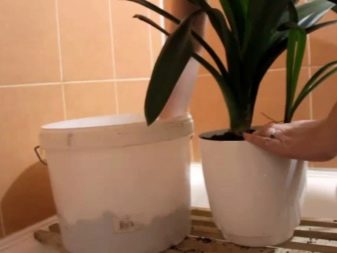
The bottom must be covered with a drainage layer of pebbles, pebbles, broken brick or gravel. Loose soil with low acidity 3 centimeters thick is laid on top. Although this compound can be purchased at the store, it is best to mold your own turf, sand, and leafy soil. For this, 5 parts of leafy earth and turf are taken, as well as one part of sand or perlite. Of the commercial mixtures, the one that is designed for orchids is most suitable.
It is important to disinfect the substrate before direct planting.
For example, the soil can be calcined for about 10 minutes in an oven heated to 200 degrees, kept for a couple of minutes in a microwave oven at maximum power, soaked in boiling water or treated with a weak solution of potassium permanganate. This action will get rid of bacteria and pest larvae. About 30 grams of fertilizers containing the required amount of phosphorus, for example, phosphate rock or superphosphate, are added to the treated soil mixture.
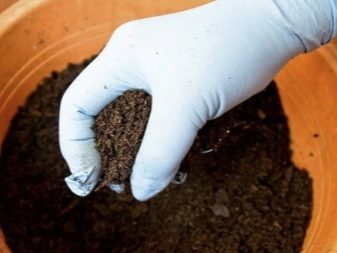
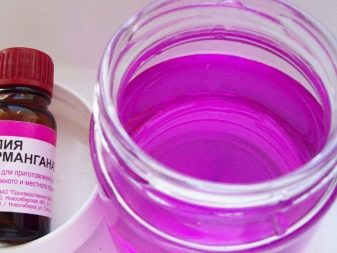
Before transplanting, the plant is moistened and left for a couple of hours, so that later the earthen lump is easier to remove. The roots are carefully washed under the tap and, if necessary, are treated from rot. Having placed the clivia in the center of the container, the voids must be filled with earth.

How to care for a clivia flower at home
If the flower is in a cold place, then it is best not to water the plant at all. When caring for clivia at home during the appearance of the first leaves and the beginning of the growth of the peduncle, it is advisable to sprinkle with warm water - if necessary, wipe the leaves with a damp cotton swab to wash off the dust.
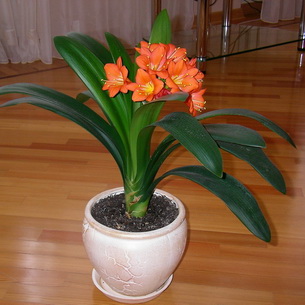
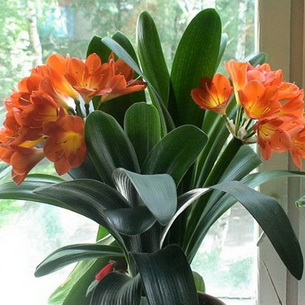
The flower is shade-tolerant and grows well even in highly shaded places, but a lighter place is needed for flowering. Direct sunlight will cause leaf burns, which will show up as brown spots. The optimal place for growing is the western and eastern windows. If you have to grow on a south window, the plant must be shaded from the sun. Growing in the north window slows down the flower's growth process and negatively affects the flowering, which may not be there.
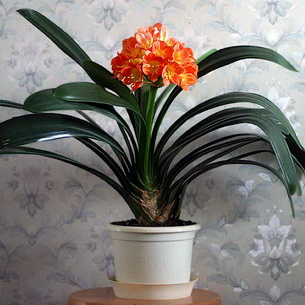
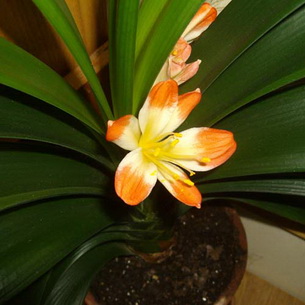
In the process of caring for the clivia at home, do not forget to water the plant sparingly, as the topsoil dries up, using soft, settled water. Do not allow water to remain in the pan. During the rest period, watering is stopped, only slightly moisten the soil, if the leaves wither... After the formation of buds, it is necessary to water it more often, more abundantly and with warm water.
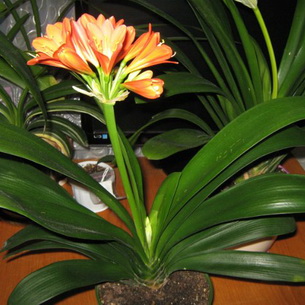
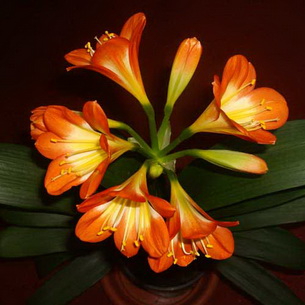
When caring for and reproducing clivia at home, it is important to consider that maintaining a dormant period is an important part of growing a plant, otherwise the flower will not bloom. In the second half of September or early October, it is necessary to put a flowerpot with a flower in a shaded place and reduce watering and feeding as much as possible, however, you need to regularly monitor the condition of the leaves
If the leaf plates begin to wither, you can slightly moisten the soil. After 2-3 months, you can resume the usual care. The older the plant, the longer it needs a dormant period.
Diseases and pests
Among insects, the enemies of clivia are mealybugs and scale insects.
The presence of a mealybug can be seen by the appearance of "white wool" on the plant, and in later stages by yellowed leaves.
The scale insects are noticed by the dark plaques on the leaves of the plant.
Adults hide under the plaques, and the larvae spread throughout the plant, covering the surfaces with new spots. While there are few parasites, they can be removed with a swab dipped in soapy or soapy tobacco water, and then the leaves can be washed under the shower.
If this is not enough, you need to spray the plant with 0.15% actellik solution (1-2 ml per liter of water).
IMPORTANT! Pests can get into the house with ready-made soil; in order to avoid this, it is better to disinfect the soil before planting again.
Gray rot creates many problems for the gardener and the fungus: from it the leaves are covered with brown spots. It is necessary to urgently treat damaged leaves with Champion, Topaz or Bordeaux liquid, and in severe cases, copper sulfate.
Why do the leaves of clivia turn yellow?
Yellowing of leaves can be caused by natural causes (partial death of leaves during dormancy, consequences of transplanting or weakening of the plant during seed ripening). But more often this is a consequence of improper care of the clivia: too abundant or, conversely, poor watering, lack of nutrition, etc. Now you know how to deal with it.
Home care for clivia
Clivia - what home care does she need? This flower requires watering with soft, settled water. Between them, it is better for someone to let the earth dry out slightly. Do not allow water to remain in the pan. During dormancy, the plant is not watered or it is done when it begins to shed its leaves.
Note! When the buds are tied on the peduncle, the clivia is watered more abundantly, and only with warm water.
Illumination and temperature conditions
Clivia is a fairly light-loving plant. When choosing a place for it, preference should be given to windows on the east side. It is advisable to avoid strong, burning sun so as not to damage the leaves. The optimum temperature for clivia is about 20-25 degrees in summer, and from October until the beginning of flowering, it is recommended to lower the temperature to 14, or even 12 degrees.

Culture feels good on east windows
In addition, it should be borne in mind that large plants need a longer wintering period. Young plants can stay cool and calm for one and a half to two months.
Watering rules and humidity
Clivia needs moderate watering and only after the topsoil is dry. The water intended for irrigation must be soft (for this, ordinary tap water must be boiled). In waterlogged clivia, the tips of the leaves become brown, the roots and base of the stem can rot.
The dormant plant does not need to be watered. It is permissible to do this if the leaves begin to dry out. With the appearance of an arrow-peduncle, watering must be resumed, but on condition that the peduncles are at least 10-15 cm in length. The same goes for moving the plant to a warm place to bloom.
You don't have to worry about air humidity when growing a flower. If the leaves are dusty, you can wipe them with a cloth. In summer, the flower will feel good in the fresh air.
Note! It does not have special requirements for air humidity
Top dressing and soil quality
The plant needs feeding not only in the flowering phase, but also during active growth. By this time, you will have to prepare fertilizer for the soil. The soil for the clivia flower needs a slightly acidic one with a high drainage layer. Top dressing should be done 2 times a month.
When choosing a fertilizer, you should pay attention to the content of substances: it is not recommended to exceed the amount of nitrogen. Failure to comply with these rules can negatively affect the flowering of the culture.
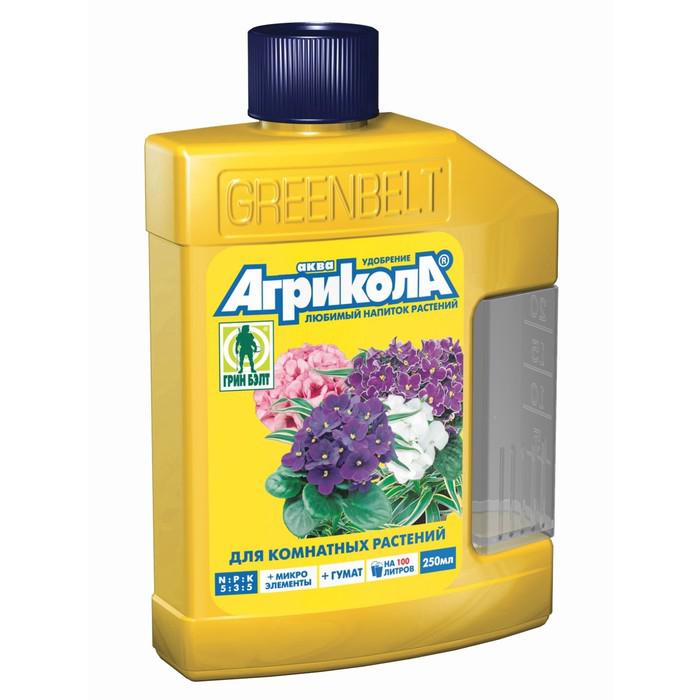
Klivia is fed with drugs with a reduced nitrogen content
Flower container size
Clivia does well in a cramped pot so that the roots can barely fit in it.That is why you should not rush to transplant a plant into a larger pot. It can bloom badly. In addition, you need to transplant the flower shallowly so that the root collar is almost on the surface of the substrate. If not properly cared for at home, the leaves of the clivia flower can rot and bloom.
Note! The plant pot must be chosen so that the root system fills it completely. If you take too large a container, then it may not bloom until the roots surround the entire lump of soil
It is desirable that the pot is ceramic
If you take too large a container, then it may not bloom until the roots surround the entire lump of soil. It is desirable that the pot is ceramic.
Transfer
This flower does not tolerate transplantation quite well; damaged roots can rot. Therefore, without the need, such a procedure for a clivia flower at home is not recommended. You can just do a transshipment. Adult clivias pass immediately after flowering, no more than two years later. Young plants are reloaded every year.

Clivia transplant at home is undesirable
When transplanting for clivia, you need to select the appropriate soil. It is advisable to renew the top layer (up to 5 cm). The soil should be chosen loose, slightly acidic (turf, peat, compost in a ratio of 2: 1: 1). You can add coarse sand, perlite, or any ripper.
How to care
Clivia is a plant that does not require special skills from a grower. To ensure her a comfortable growth, it is enough to follow the rules of watering and feeding, as well as create certain conditions during rest.
Watering
Clivia is a plant that does not like high soil moisture. Therefore, it should be watered only after the earthen lump dries up. Excess water from the pan should be discarded. If you neglect this rule, the roots of clivia can rot.
When the plant enters the resting stage, and the temperature in the room is reduced, watering is practically stopped, it is enough to moisten the soil every 10 days. After the flower stalks are formed on the clivia, the plant begins to be watered again as the soil dries.
Tap water must be defended before watering
It is important that it is soft enough, without chlorine.
Air humidity for clivia is not critical. Therefore, it is not required to spray it from a spray bottle. However, the plant is responsive to removing dust from leaves with a damp cloth.
Top dressing
Clivia is susceptible to feeding. They help her to develop intensively and make her outwardly more decorative. Top dressing should be started from the first year of life in the summer. It is necessary to fertilize clivia during the growth and flowering period once every 2 weeks, alternating organic and mineral products.
It is best to use organic fertilizers based on vermicompost. It can be Ideal, Giant, Breadwinner and others. For their use, 1 tablespoon of fertilizer is diluted in 2 liters of water.
Mineral complexes are diluted in warm water in a ratio of 2 g of fertilizer per 1 liter. The most commonly used are Ammophos, Kemira, Nitrofoska.
After the onset of the rest period (approximately from the beginning of autumn), feeding should be stopped, and resumed when the flower releases the arrow of the peduncle.
Flowering time
Clivia usually begins to bloom in late winter or early spring and lasts for about a month. When the flower arrow is high enough (more than 10 cm), you should end the rest period and move the flower from an unheated room to a warm and well-lit place.
During flowering, you should increase the watering of the clivia and fertilize it regularly. For irrigation, it is better to take warm water, with a temperature 3-4 degrees above room temperature. If you do not start leaving on time, the peduncle will be short, and the flowering time will be significantly reduced.
What to do to make the clivia release its peduncle arrow and bloom
Usually the lack of rest prevents clivia from flowering.If in the autumn-winter time you do not reduce watering and lower the temperature, it is unlikely that it will be possible to make the clivia bloom.
When the arrow appears, the plant should be washed with warm water from the shower, increased watering and start fertilizing. The first feeding is high in potassium (potassium chloride, potassium salt, potassium sulfate).
If the clivia does not bloom by this time, it needs a long rest. For this, the plant is transferred to a dimly lit place with an air temperature of no higher than 16 ° C for 3-4 weeks.
Another reason for the lack of peduncles is too spacious a pot: clivia will not bloom until the roots fill it completely.
When the clivia has faded and the peduncle is cut off: a dormant period
It is important for Clivia to create conditions for rest during the winter. At this time, you can take the flower pot out to the glazed loggia or to another cool room.
The main thing is that the air temperature is not below + 12 ° C, otherwise the plant may die.
The older the clivia, the longer it will take to rest. It is enough for young plants to rest for two months - from the end of September to November. When the flower is more than five years old, the dormant period should be increased. From this moment, the clivia needs rest for the entire autumn-winter period - from mid-September to early February.
Can a plant bloom twice a year
It is better to transfer faded clivia to fresh air - a balcony or a garden. The place for the plant should be shady and windless.
If you want to get the plant to bloom again this year, after a short break in nature, the clivia should be taken to a poorly lit place and stop fertilizing, and also reduce watering to 1 time per month. The leaves may start to turn yellow, but that's okay. In about a month, wait for a new arrow to appear.
Clivia after flowering
Caring for clivia after flowering
The annually blooming clivia needs a dormant period, which usually occurs in October-November and can last two to three months. But in order for the plant to fully regain its strength, it needs to create certain conditions: watering clivia is gradually reduced, feeding is stopped completely, the plant is kept at a temperature of 10-14 ºC. Watering the resting clivia is carried out when its leaves begin to dry out or fall off. As soon as you notice that the plant has released a peduncle, the usual watering regime is gradually restored and fertilizers begin to be applied.
Description of the plant and types of indoor clivia
Clivias have long been considered obsolete and purely greenhouse plants, but today they are gaining popularity again in indoor culture. This is one of the most original plants among beautifully flowering indoor plants and one of the brightest exotic plants.
Also known as the Kaffir lily, members of the Amaryllis clivia family are controversial. This plant is literally overgrown with myths. Even the belonging of clivia to rhizome perennials or bulbous plants is argued.
Clivias have a thickened, shortened rhizome that resembles a daylily and do not form bulbs. Specific clivias reach a height of 80 cm, modern varieties and hybrids are much more compact.
Arranged in two rows, belt-shaped or oar-shaped, rather long and wide leaves form false stems. With a length of up to 60 cm, clivia leaves are reminiscent of daylilies. But, thanks to the rich color and density, giving the leaves a slight arched bend, they win in comparison. Plants have a very effective glossy sheen.
Clivias can surprise many, but first of all - their longevity. Clivia can please 40 years or more under the right growing conditions!
Despite the classic flowering period from late February to May, clivia often blooms a little later, in March. On strong, powerful peduncles, umbrellas of inflorescences rise above the leaves.Young clivias produce one or more peduncles, but old overgrown plants, especially after the first decade, are able to please fifty peduncles per season.
Up to 60 large funnel-shaped flowers are collected in clivium-umbrella inflorescences. The graceful bells are very elegant. After flowering, large berry-like fruits are tied.
The yellow-orange hues of clivia flowers are reminiscent of summer fruits. Creamy, apricot, melon, pinkish peach, cinnabar pink clivias always look sunny and dazzlingly bright.
Clivias belong to the poisonous houseplants, which require protection of the skin from any contact with sap during work.
Types of indoor clivia
Clivia cinnabar, or clivia orange (Clivia miniata) - the most common and vibrant type of clivia. Belt-shaped leaves with a very dark shade of color are striking in their beauty. But this species is appreciated for flowering - massive yellow, orange or light red inflorescences of large flowers.
Clivia nobilis differs only in elongated tubular drooping flowers of predominantly pink color.
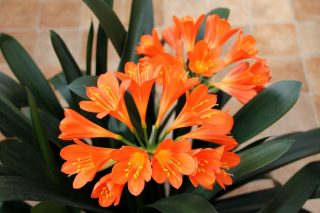 Clivia cinnabar, or Clivia orange (Clivia miniata). Nasr Habib Abdalla
Clivia cinnabar, or Clivia orange (Clivia miniata). Nasr Habib Abdalla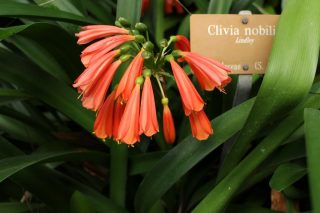 Clivia nobilis. Ghassen labidi
Clivia nobilis. Ghassen labidi
Description of Cinnabar clivia and other species
The plant can reach a height of 60 cm. As you can see in the photo, the long, leathery, dark green leaves are tightly gathered on both sides at the base and unite into a false stem, which resembles a pigtail in its appearance. Their spectacular appearance 1 or 2 times a year is complemented by beautiful flowers in a multi-flowered umbrella (red, red-yellow, orange, yellow, pink, white, etc.).
The most popular among gardeners are species that attract bright colors of leaves and flowers, as well as are resistant to most diseases and pests:
-
Clivia Cinnabar (Latin Clivia miniata) is the most common species in indoor and greenhouse culture. The Miniata owes its name to the cinnabar or red lead color. The leaves are like swords, to the top they become narrow, reaching a length of 60 cm, and a peduncle with 1-2 dozen orange-red funnel-shaped flowers with a yellow throat is 50 cm.
-
Clivia the Beautiful (or Noble) is more compact, it rarely exceeds a height of 30 cm. It has a high peduncle, on which curved-drooping carrot-colored flowers bloom. There can be up to fifty of them.
-
Clivia Gardena has lighter leaves than relatives. They are bright green, have a crest below. The plant can reach a height of 50 cm. Narrow tubular flowers bloom in small numbers (up to 16 pieces). Coloring, depending on the variety, is different (pale yellow, deep orange, etc.). A definite plus is shade tolerance.
The listed species became the basis for the creation of many varieties and hybrids. They are a little easier to care for than, for example, Clivia Stemleva or Amazing (one is more demanding for watering, the other is susceptible to root rot).
An inexperienced grower is recommended to acquire an adult specimen, preferably before flowering, the peduncle should rise only up to ½ leaves. Clivia should not be very sprawling. Of course, an examination is necessary for the presence of damage and signs of disease.
It will also be interesting: Clerodendrum Filipino - caring for a plant at home?

